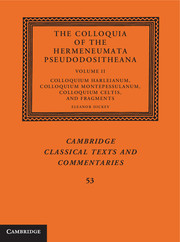Book contents
- Frontmatter
- Dedication
- Content
- List of plates page
- List of figures
- Acknowledgments
- Part One Colloquium Harleianum
- 1 Introduction to the Colloquium Harleianum
- TEXT, TRANSLATION, AND CRITICAL APPARATUS
- 2 Index Siglorum
- 3 Colloquium Harleianum
- Commentary
- 4 Commentary
- Part Two Colloquium Montepessulanum
- 5 Introduction to the Colloquium Montepessulanum
- Text, Translation, and Critical Apparatus
- 6 Index Siglorum
- 7 Colloquium Montepessulanum
- Commentary
- 8 Commentary
- Part Three Colloquium Celtis
- 9 Introduction to the Colloquium Celtis
- Text, Translation, and Critical Apparatus
- 10 Index Siglorum
- 11 Colloquium Celtis
- Commentary
- 12 Commentary
- Part Four Related texts
- 13 Editions of Papyri Connected to the Colloquium Tradition
- 14 The Berlin Trilingual Papyrus (P.Berol. INV. 10582): Reprinted Edition
- 15 Assorted Conversational Fragments(P.Berol. INV. 21860): New Edition
- 16 A Glossary Including Conversational Phrases (P.Lond. II.481): New Edition
- 17 A Glossary of Homonyms with Grammatical Information (P.Sorb. INV. 2069 Verso): Reprinted Edition
- 18 Grammatical Paradigms for Latin Learners (P.Louvre INV. E 7332): Reprinted Edition
- Endmatter
- References
- Indices to volumes I and II
- Index of notable Greek words and phrases
- Index of notable Latin words and phrases
- Index of topics mentioned in the colloquia
- Index of subjects discussed in the introduction and commentary
9 - Introduction to the Colloquium Celtis
Published online by Cambridge University Press: 25 November 2020
- Frontmatter
- Dedication
- Content
- List of plates page
- List of figures
- Acknowledgments
- Part One Colloquium Harleianum
- 1 Introduction to the Colloquium Harleianum
- TEXT, TRANSLATION, AND CRITICAL APPARATUS
- 2 Index Siglorum
- 3 Colloquium Harleianum
- Commentary
- 4 Commentary
- Part Two Colloquium Montepessulanum
- 5 Introduction to the Colloquium Montepessulanum
- Text, Translation, and Critical Apparatus
- 6 Index Siglorum
- 7 Colloquium Montepessulanum
- Commentary
- 8 Commentary
- Part Three Colloquium Celtis
- 9 Introduction to the Colloquium Celtis
- Text, Translation, and Critical Apparatus
- 10 Index Siglorum
- 11 Colloquium Celtis
- Commentary
- 12 Commentary
- Part Four Related texts
- 13 Editions of Papyri Connected to the Colloquium Tradition
- 14 The Berlin Trilingual Papyrus (P.Berol. INV. 10582): Reprinted Edition
- 15 Assorted Conversational Fragments(P.Berol. INV. 21860): New Edition
- 16 A Glossary Including Conversational Phrases (P.Lond. II.481): New Edition
- 17 A Glossary of Homonyms with Grammatical Information (P.Sorb. INV. 2069 Verso): Reprinted Edition
- 18 Grammatical Paradigms for Latin Learners (P.Louvre INV. E 7332): Reprinted Edition
- Endmatter
- References
- Indices to volumes I and II
- Index of notable Greek words and phrases
- Index of notable Latin words and phrases
- Index of topics mentioned in the colloquia
- Index of subjects discussed in the introduction and commentary
Summary
This version of the colloquia is known sometimes as the colloquium Celtis, after the Renaissance scholar who made the only surviving copy of it, Conrad Celtes, and sometimes as the colloquium Vindobonense, because that sole copy is now in Vienna. It is attested only in a late and corrupt form and is full of vocabulary lists that break up the flow of the narrative, but it clearly contains much ancient material, and because the colloquium Celtis is one of the longest versions of the colloquia it provides a significant portion of our evidence for them. This colloquium is better known than the others, because it was first published by Dionisotti (1982) in an article much more accessible than Goetz's work on the other colloquia.
SOURCE FOR THE TEXT
Only one manuscript of this version is known, codex suppl. Gr. 43 in the Österreichische Nationalbibliothek in Vienna (C). It contains the colloquium on folios 12r–17r, preceded by a Renaissance grammar of Greek (folios 1 verso–11 verso) and followed by a very long capitula section (folios 18r–45v). The text is arranged not in the usual narrow columns but in long lines running the full width of the page, with the Greek above the corresponding lines of Latin. Despite the late date of the manuscript it is almost completely without accents, breathings, subscripts, and punctuation. There is no ornamentation except that the Latin is written in black and the Greek in red.
The colloquium section of the manuscript was written in 1495 by the humanist Conrad Celtes, copying a much earlier exemplar that has since disappeared. The exemplar was housed in the German monastery of Sponheim and is probably identifiable with entry 18 in a contemporary catalogue of the Greek works in that monastery, which describes it as codex arcualis formae scriptus, q(ui) co(n)tinet Graecu(m) vocabulariu(m) cu(m) Latino supposito M. Tullii Ciceronis ad filiu(m) suu(m), secu(n)du(m) materias in varios titulos partitu(m), l(iber) 1 ‘a quarto volume that contains a Greek vocabulary, with the Latin placed underneath, of M. Tullius Cicero to his son, divided into various chapters according to the material, one book’.
- Type
- Chapter
- Information
- The Colloquia of the Hermeneumata Pseudodositheana , pp. 141 - 162Publisher: Cambridge University PressPrint publication year: 2015
- 1
- Cited by



